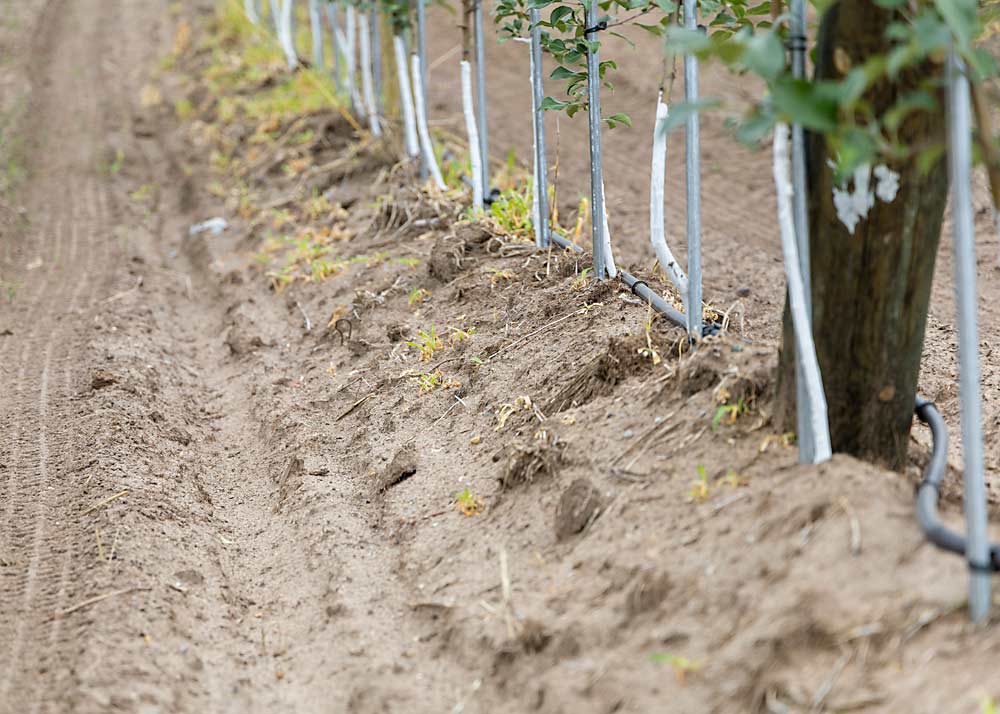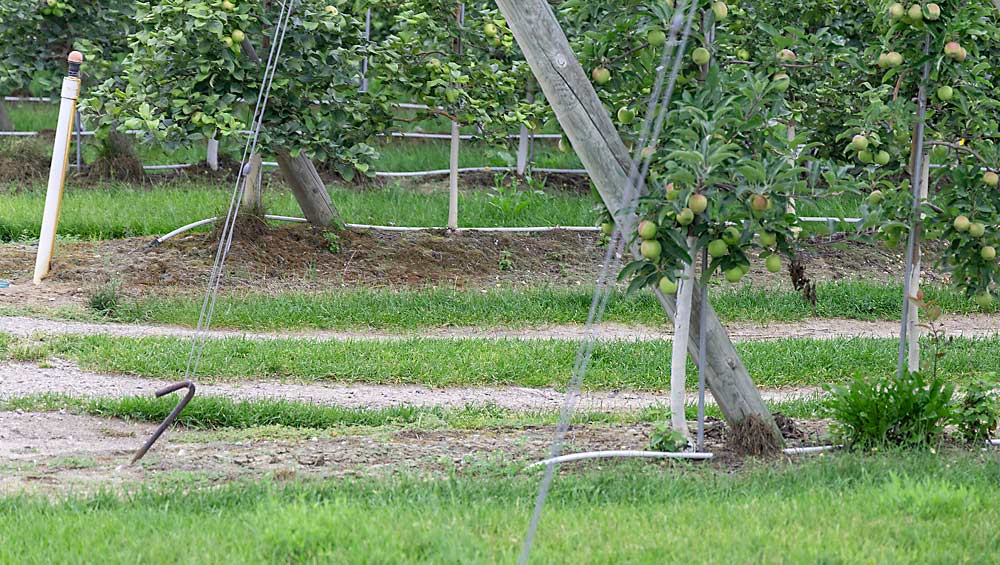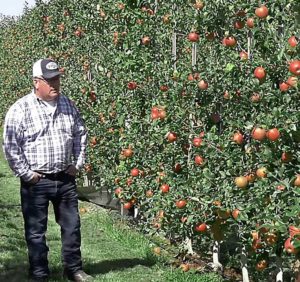
Mounding soil around apple trees is not a common practice in Michigan, but the positive experience of growers who do it inspired the Northwest Michigan Horticulture Research Center to plant a trial and test the benefits of the technique.
Chris Kropf, owner of Hart Farm in Greenville, northeast of Grand Rapids, started mounding about a decade ago and now does it on just about all of his apple trees. Mounding his loamy soil around trees planted on dwarfing roots boosts their vigor and nutrition levels, and it also improves the water-holding capacity, with more soil in place, he said.
To do it, he drives a tractor-led backblade down his rows a couple of months after planting, pushing topsoil into a furrow around the trees. He tries to keep his graft unions 6 to 8 inches aboveground, so the mounded dirt comes right up to, or even covers, them. He only mounds the trees once.
Kropf decided to try mounding after observing apple growers do it in other parts of the world. He started on bigger rootstocks, such as Malling 337 and Nic.29, and noticed that the mounded trees grew more consistently and filled in their canopies faster than the unmounded trees. The difference is especially noticeable for low-vigor rootstocks such as Budagovsky 9, he said.
At this point, Kropf has mounded virtually all of his nearly 130 acres of apples. To him the benefits are clear, especially for rootstock/variety combinations — such as Honeycrisp on B.9 — that need all the vigor they can get.
About a two-hour drive north of Kropf’s orchard, near the town of Williamsburg, grower Travis Bratschi displayed his own mounding efforts. Like most growers in Northwest Michigan, Bratschi’s soils are sandier than the loamy soils found in greater Grand Rapids. He started mounding in 2014 because he wanted more vigor for his young Honeycrisp trees, which were struggling, and he wanted better protection from cold damage.

The first trees he mounded were four rows of Honeycrisp on Nic.29, planted at 3-foot by 11-foot spacing in 2012. The trees were struggling at the time, but after he mounded them, they started filling space, and they’ve performed consistently ever since. He said mounding improves return bloom and protects graft unions from cold damage; he’s lost virtually none of his mounded trees to cold. He has not seen any signs of scion rooting in his mounded trees.

Bratschi mounds all of his Honeycrisp trees now, including a 3.5-acre block on B.10 he planted in March. He might mound his Galas in the future — at least the ones on rootstocks that are susceptible to winter damage, he said.
To further study the potential benefits of mounding in Northwest Michigan, researchers at the Northwest Michigan Horticulture Research Center planted a trial block in 2019. The block consists of mounded Fuji and Honeycrisp trees, mostly on Geneva 935 with some Nic.29. They built up the mounds about 5 inches above the graft union. Center director Nikki Rothwell said she expects to start collecting data from the block next year.
In Northwest Michigan’s sandy soils, trees sometimes struggle to reach the top wire. By putting a greater amount of soil around the trees and encouraging “a little bit” of scion rooting, mounding could give them the extra “oomph” they need, Rothwell said.
One potential drawback: The scion rooting could possibly discourage the rootstock’s dwarfing tendencies. But there might be ways to turn off that extra vigor when it’s no longer needed — including unmounding the trees when they’re ready to bear fruit, Rothwell said.
Kropf doesn’t think unmounding trees is necessary. By the time his trees are about 4 years old and ready to bear fruit, the mounded dirt around them has pretty much dissipated. He said mounding doesn’t seem to have much of an effect on the dwarfing tendency of rootstocks. His trees on B.9 are no larger than he needs them to be.
—by Matt Milkovich







but what about the root flare and trunk collar being able to breath? this is an important factor with trees in general. doesn’t mounding reduce this? how would it increase vigor if covering the root flare slowly leads to the demise of a tree.